
Genetics and breeding for specific traits is a little like playing poker. A face card wins unless someone has two lower cards together.
Example Genes for explanatory purposes:
Each horse has two genes for each trait.
B= Black; Upper case genes are Dominant Genes. They are the face cards in the deck.
Any horse with a B gene will be black no matter the color of his partner.
p= pink; lower case letters are recessive genes (lower cards). They are not visible (“expressed”) unless there are two of them (pp) one from each parent. Two lower cards trump a face card.
Whether a horse is Black or pink will depend on the B gene. If he is dealt even one B, he will be Black because Black trumps pink. But if he is dealt two pinks then he is pink. A pair of recessive pink genes wins the hand.
There are four possible hands. Each colt gets one gene from each of his parents.
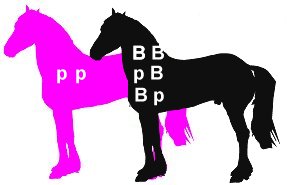
BB one chance in 4: Horse is black and his offspring can only get a B gene
Bp one chance in 4: Horse is black and his offspring can receive either a B gene or a p gene
pB one chance in 4: Horse is black and his offspring can receive either a B gene or a p gene
pp one chance in 4: Horse is pink and his offspring can only receive a p gene
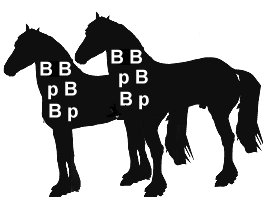 A foal gets one gene from each parent. In the case of two black parents, we are certain that each parent has at least one B gene because each is visibly black. Therefore, we are certain that our foal will have at least one Black gene and possibly two Black genes (one from each parent). That is all we know for sure.
A foal gets one gene from each parent. In the case of two black parents, we are certain that each parent has at least one B gene because each is visibly black. Therefore, we are certain that our foal will have at least one Black gene and possibly two Black genes (one from each parent). That is all we know for sure.
Each parent could have two B’s (BB=black horse) or one B and a p (Bp=black horse with a silent pink ancestor). (see image above)
We do not want any pink horses in our herd. But we do not know if our black stallion from two Black parents has pink genes we cannot see. There is a chance that our stallion could pass a pink gene along without our suspecting it. We want to advertise that he is not a carrier of pink. We want to advertise that he will sire only Black horses no matter what the color of his partner.
How do we find out?
If we breed the stallion to a pink horse, there is a 50% chance that the offspring will be pink if the father has a silent pink gene.
detail:
Sire has at least one B gene. He could have two B’s (Black/Black) or he could have a Black and an “unexpressed” (invisible) pink (Black/pink).
Dam is “expressing” (showing) pink. She MUST have two p’s (pink/pink) and can only pass along a pink gene.
If the foal is black, the trial breeding is inconclusive and a whole year is wasted. We cannot be sure if our stallion has a pink recessive gene from one of his parents and passed it to the foal invisibly. (image below)
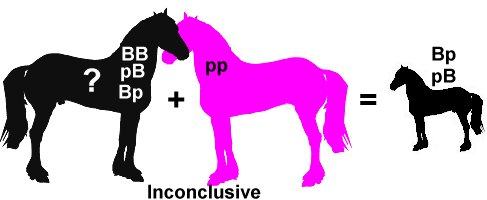
However, if the foal is pink, there is no doubt that the sire has an unexpressed pink gene. The dam could only pass a pink gene. The stallion could have passed a Black gene (we can see he has one), but he MUST have passed a pink. He cannot be advertised or bred with the certainty of throwing only Black foals. This may be cause for excluding him from any further breedings whatsoever. (If you change the name of the pink gene to Cryptorchid or some other very undesirable inheritable condition)
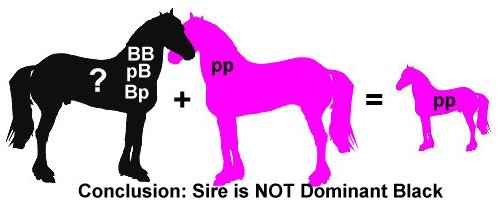
The reason that dog breeders do such experimental breedings more frequently than horse breeders do is because a litter of puppies has several chances of at least one showing the pink gene and proving conclusively that the parent has a pink gene. Only one season is “wasted”, and the parent(s) can be excluded from any further breeding (ie: change pink to dysplastic hips or genetic blindness) if the undesirable trait shows.
Horse breeders rarely do such experimental breedings because there is just one offspring and the test is only 50% conclusive. However in the case of a very important trait, some inbreeding or purposeful recessive-baiting might be necessary to breed a particularly bad trait out or “set” a double-dominant good trait.
ie: We purchased a “few spot” appaloosa mare. She is a product of inbreeding to “set” her appaloosa pattern to her foals. She ALWAYS throws a spotted baby. In the process we also found that she is healthy and seems to have few other genes that have come forward as pp that might exclude her or her parents from breeding. She could have been born a disaster. In that case her breeders would have been disappointed, but would have found out something about her parents’ undesirable recessive genes as compensation.
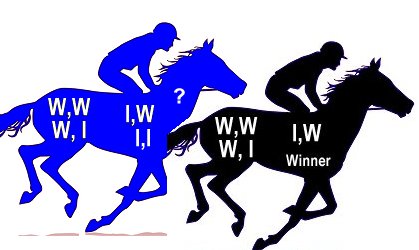 Winning Race Horses?
Winning Race Horses?
Still Simple Genetics but harder to visulaize: A horse who wins races bred to a horse that wins races is more likely to produce a winner if winning is W. Further, that winner bred back to her winning father might produce a Double Dominant winner – a Super-Breeder of only winners. (WW).
However, if bred back to the sire and a loser ensues, the sire and dam could both be carrying a loser gene (l), and (loser/loser) would be the result. That is important to know.
Horse breeders prefer to keep breeding winning stallions to mare after mare to get a broad sampling of foals whose probabilities become apparent over time and mass breedings. If a super-Winner is bred to a loser and still produces a Winner, then it becomes more and more evident that the sire is always overcoming the loser trait and is probably double-dominant (WW) for the winning trait. His stud fees go up accordingly. (Of course, the super Winner could be a mare also and able to produce Winners in spite of lower quality stallions – though one would wonder what the purpose of breeding to poor quality stallions would be)
If we reverse the dominant and recessive characteristics, winning is (ww) recessive and Loser is (L), when our (ww) stallion is bred to a mare who is a winner (ww) and the foals get winner/winner genes. But if he is bred to a mare who is a loser (LL or Lw), then there is a 50% chance that the foal will be dealt the face card “L” from his dam and be a loser (wL).
That loser filly (wL) bred back to a winner (ww) could produce a (ww) by donating her w to the sire’s certain w. This may be how a Loser from good background produces 50% winners.
While we’re still not getting away from “simple” genetics, we are getting complicated enough that your first lesson might be overwhelming.
There are rarely such clear and simple genetics involved in breeding programs. However, traits are determined by genes, and horses with a desirable trait bred to another horse with a desirable trait certainly has a better chance of producing a horse with that desirable trait. Repeated over several generations, the W gene might be distilled and a horse of giant breeding potential might develop.
Or, carefuly planned experimental breedings can make hidden, dangerous recessive traits become visible and precautions can be taken in the further breeding of such animals.
At any rate, once you are hooked on genetics and breeding, the gambling begins.